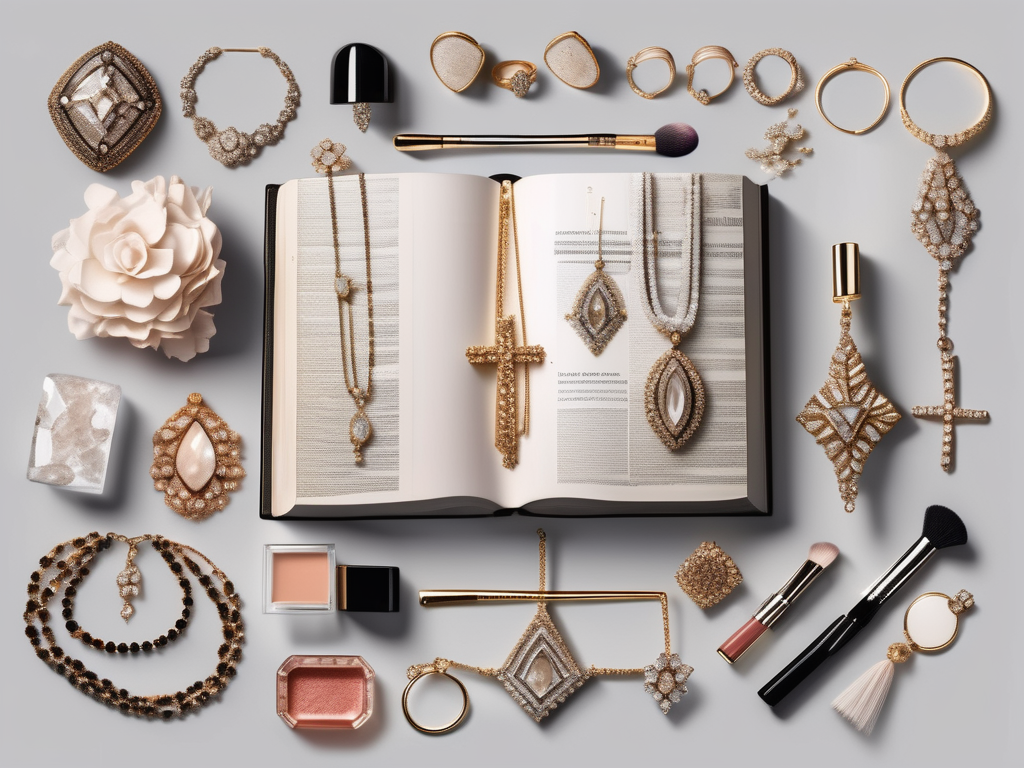Jewelry has been a part of human culture for thousands of years, but what does the Bible say about its use and significance? In this article, we will explore the biblical perspective on jewelry, its role in ancient times, how passages about jewelry can be interpreted, the ongoing theological debates, and how we can apply biblical teachings on jewelry in our modern lives.
Understanding the Biblical Perspective on Material Possessions
The Bible contains teachings about the proper use and attitude towards material possessions. It emphasizes the importance of not letting material things become idols or distractions from our faith. It is in this context that we can explore what the Bible says specifically about jewelry.
Material possessions have always played a significant role in human societies, and the Bible acknowledges this reality. In ancient cultures, including the Israelites, jewelry and adornments were commonly used as symbols of status, wealth, and beauty. However, the Bible also cautions against excessive focus on outward appearances and advises prioritizing inner virtues.
One example of this can be found in the story of Jacob. When Jacob’s household decided to return to Bethel, the place where God had appeared to him, Jacob instructed his household to bury their idols and cleanse themselves of any jewelry associated with false gods (Genesis 35:1-4). This act symbolized the importance of removing any connection with idolatry and placing God above material possessions.
The New Testament’s View on Jewelry
In the New Testament, the focus shifts towards the inward transformation of individuals through faith in Christ. While the Bible does not explicitly condemn the wearing of jewelry, it emphasizes the pursuit of inner beauty and character rather than external display.
For instance, the apostle Peter advises women to focus on their inner self and cultivate a gentle and quiet spirit, rather than placing excessive importance on outward adornment (1 Peter 3:3-4). This does not mean that wearing jewelry is inherently wrong, but rather that its significance should not overshadow one’s character and faith.
It is important to note that the Bible’s teachings on material possessions, including jewelry, are not meant to discourage the enjoyment of beautiful things or to promote asceticism. Instead, they serve as a reminder to keep our priorities in check and to ensure that our hearts are not consumed by the pursuit of material wealth.
Ultimately, the biblical perspective on material possessions, including jewelry, calls for a balanced approach. It encourages us to appreciate the beauty of the world around us while remaining mindful of the dangers of materialism and the importance of cultivating inner virtues.
Jewelry in Biblical Times
Jewelry held significant cultural and symbolic meaning in biblical times. It was often associated with ceremonies, celebrations, and acts of worship. Understanding the context can provide insights into the biblical references to jewelry.
In ancient times, jewelry was more than just adornment. It was a reflection of one’s status and power. The more jewelry a person possessed, the higher their social standing. It was a way for individuals to display their wealth and influence to others. The intricate designs and precious materials used in jewelry were a testament to the craftsmanship and skill of the artisans who created them.
Ancient cultures, including those mentioned in the Bible, attached great significance to jewelry. It was seen as a sign of wealth, power, and social standing. Some jewelry had religious or spiritual connotations, symbolizing devotion and allegiance to a particular deity.
For example, the golden calf created by the Israelites in the wilderness (Exodus 32:2-4) was a representation of idolatry and a violation of God’s commandments. This serves as a reminder to be cautious about the symbolic associations of certain jewelry.
Significance of Jewelry in Ancient Cultures
The significance of jewelry in ancient cultures cannot be overstated. It was not merely a fashion statement, but a reflection of one’s identity and beliefs. In many societies, jewelry was believed to possess magical or protective powers. It was thought to ward off evil spirits and bring good fortune to the wearer.
Ancient Egyptians, for example, adorned themselves with jewelry that represented their gods and goddesses. The pharaohs wore elaborate crowns and necklaces adorned with precious gemstones, symbolizing their divine authority. In Mesopotamia, jewelry was often buried with the deceased as a way to accompany them in the afterlife.
Throughout history, jewelry has also been used as a form of currency and trade. It was a portable and valuable asset that could be easily exchanged for goods and services. In biblical times, jewelry was often given as a gift to show appreciation or as a sign of honor. It was a way to establish alliances and strengthen relationships between individuals and communities.
Types of Jewelry Mentioned in the Bible
The Bible mentions various types of jewelry, such as earrings, bracelets, necklaces, rings, and even crowns. These items were often used as gifts, signs of honor, or symbols of authority. Some jewelry pieces had specific cultural or religious significance, such as the high priest’s breastplate (Exodus 28:15-30).
Earrings were commonly worn in biblical times, both by men and women. They were often made of gold or silver and adorned with precious gemstones. Bracelets were another popular form of jewelry, worn on the wrists or upper arms. They were often intricately designed and served as a symbol of beauty and femininity.
Necklaces were also highly valued and were often made of gold or silver chains with pendants or amulets attached. Rings were a symbol of authority and were worn by kings and nobles. They were often engraved with intricate designs or inscriptions.
It is important to note that the Bible itself does not prescribe specific guidelines on what types of jewelry are acceptable or unacceptable for believers to wear. Rather, it encourages discernment and moderation in our choices, considering the cultural and personal implications.
As we reflect on the significance of jewelry in biblical times, let us remember that it is not the outward appearance or material possessions that truly matter, but the condition of our hearts and our relationship with God and others.
Interpreting Biblical Passages About Jewelry
When interpreting biblical passages about jewelry, it is crucial to consider the larger context, cultural background, and literary devices used in the text. Some passages may employ symbolism and metaphors involving jewelry, requiring a deeper understanding to grasp their intended meaning.
Throughout the Bible, jewelry is used symbolically to express various concepts. For instance, the prophet Isaiah refers to the restoration of Jerusalem as adorning it with “a diadem instead of ashes” and “the oil of gladness instead of mourning” (Isaiah 61:3). Here, jewelry serves as a metaphor for transformation and restoration.
Understanding these symbolic references helps us appreciate the biblical messages conveyed through jewelry imagery and encourages us to seek spiritual richness and inward beauty.
In addition to symbolism, jewelry is also used in parables and teachings to illustrate spiritual truths. Jesus often employed relatable imagery to convey profound lessons. In the parable of the prodigal son, for example, the father joyfully embraces his returning son and adorns him with a ring, symbolizing restoration and acceptance (Luke 15:22).
These parables emphasize God’s grace, forgiveness, and the value He places on each individual, regardless of their past mistakes or worldly possessions. They remind us to prioritize our relationship with God above material possessions.
Furthermore, jewelry in biblical times held significant cultural and social importance. It was not only a means of adornment but also a reflection of one’s status, wealth, and identity. In ancient societies, jewelry was often crafted with precious metals and gemstones, symbolizing power, authority, and beauty.
For example, in the book of Esther, Queen Esther is described as wearing a royal crown (Esther 2:17). This crown represented her position as queen and her authority in the Persian Empire. Similarly, in the book of Exodus, the high priest’s breastplate was adorned with twelve gemstones, each representing one of the twelve tribes of Israel (Exodus 28:15-21).
By understanding the cultural significance of jewelry in biblical times, we can gain a deeper appreciation for the messages conveyed through its use in the scriptures. It allows us to see how jewelry was not only a physical adornment but also a symbol of identity, power, and divine purpose.
In conclusion, interpreting biblical passages about jewelry requires careful consideration of the larger context, cultural background, and literary devices used in the text. Symbolism and metaphors involving jewelry help convey profound spiritual truths and encourage us to seek inner transformation and spiritual richness. Jewelry in parables and teachings serves as relatable imagery to emphasize God’s grace and the value He places on each individual. Additionally, understanding the cultural significance of jewelry in biblical times provides insight into its symbolic and social importance. By delving deeper into these aspects, we can uncover a wealth of meaning and significance in the scriptures.
Theological Debates on Wearing Jewelry
Throughout history, different Christian denominations have held varying views on the wearing of jewelry. These debates arise from different interpretations of biblical passages and cultural considerations.
One of the key passages that has sparked theological debates on wearing jewelry is 1 Timothy 2:9-10, where the apostle Paul writes, “I also want the women to dress modestly, with decency and propriety, adorning themselves, not with elaborate hairstyles or gold or pearls or expensive clothes, but with good deeds, appropriate for women who profess to worship God.” Some interpret this passage as a clear prohibition against wearing jewelry, arguing that it distracts from spiritual devotion and promotes materialism.
On the other hand, proponents of wearing jewelry argue that this passage should be understood within its cultural context. In ancient times, gold and pearls were often associated with wealth and extravagance, and some believe that Paul’s intention was to discourage ostentatious displays of wealth rather than condemn all forms of jewelry. They argue that wearing jewelry in moderation can be a form of self-expression and a way to appreciate the beauty of God’s creation.
Different Christian Denominations and Their Views
Some Christian denominations discourage or prohibit the wearing of jewelry, considering it a distraction from spiritual devotion or a potential source of pride. For example, certain Anabaptist groups, such as the Amish and the Mennonites, adhere to a plain dress code that includes abstaining from wearing jewelry. They believe that simplicity and modesty should be the focus of a Christian’s appearance.
On the other hand, other denominations have a more permissive view on wearing jewelry. They view it as a personal choice, as long as it is done in moderation and without excessive attachment to material possessions. These denominations often emphasize the importance of the heart and intentions rather than outward appearances.
Understanding these differing viewpoints allows for respectful dialogue and the recognition that personal convictions may vary based on individual interpretations of scripture within specific cultural contexts.
Modern Interpretations and Beliefs
In modern times, there is a wide range of perspectives on wearing jewelry among Christians. Some emphasize the symbolic and cultural aspects of jewelry, using it as a means of self-expression or a reminder of their faith. For example, a cross necklace may serve as a visible symbol of one’s Christian identity and a constant reminder of Jesus’ sacrifice.
Others focus on simplicity and minimalism, choosing to forgo jewelry altogether. They believe that detachment from material possessions, including jewelry, allows them to better focus on their relationship with God and prioritize spiritual matters over worldly possessions.
Regardless of personal beliefs, it is important to approach these discussions with humility, respecting the diversity of viewpoints within the Christian community and keeping the central tenets of faith and love at the forefront. Ultimately, the wearing of jewelry should not be a source of division but an opportunity for Christians to engage in thoughtful conversations and grow in their understanding of God’s Word.
Applying Biblical Teachings on Jewelry in Modern Life
As we navigate the complexities of modern life, we can draw wisdom from the Bible’s teachings on jewelry and apply them in practical ways that align with our faith.
Balancing Faith and Fashion
We can balance our love for fashion and personal style with our faith by approaching jewelry with moderation and mindfulness. Rather than allowing jewelry to become a measure of our worth or identity, we can choose pieces that reflect our values and bring glory to God.
By focusing on the inward qualities of love, joy, peace, patience, kindness, goodness, faithfulness, gentleness, and self-control (Galatians 5:22-23), we can prioritize inner beauty and character over outward appearance.
Jewelry as a Form of Worship or Idolatry
For some, wearing jewelry can be a way of expressing devotion to God or celebrating His blessings. However, we must remain vigilant to avoid slipping into idolatry or excessive materialism. Regularly examining our hearts and motives helps us ensure that our jewelry choices align with our faith and do not become distractions from worshipping and serving God.
In conclusion, the Bible offers guidance on jewelry that encourages discernment, moderation, and a proper perspective on material possessions. It reminds us that our worth is not defined by outward adornment but by our character, faith, and relationship with God. By applying these principles to our modern lives, we can strive for a balanced approach to jewelry that aligns with our faith and honors our Creator.












